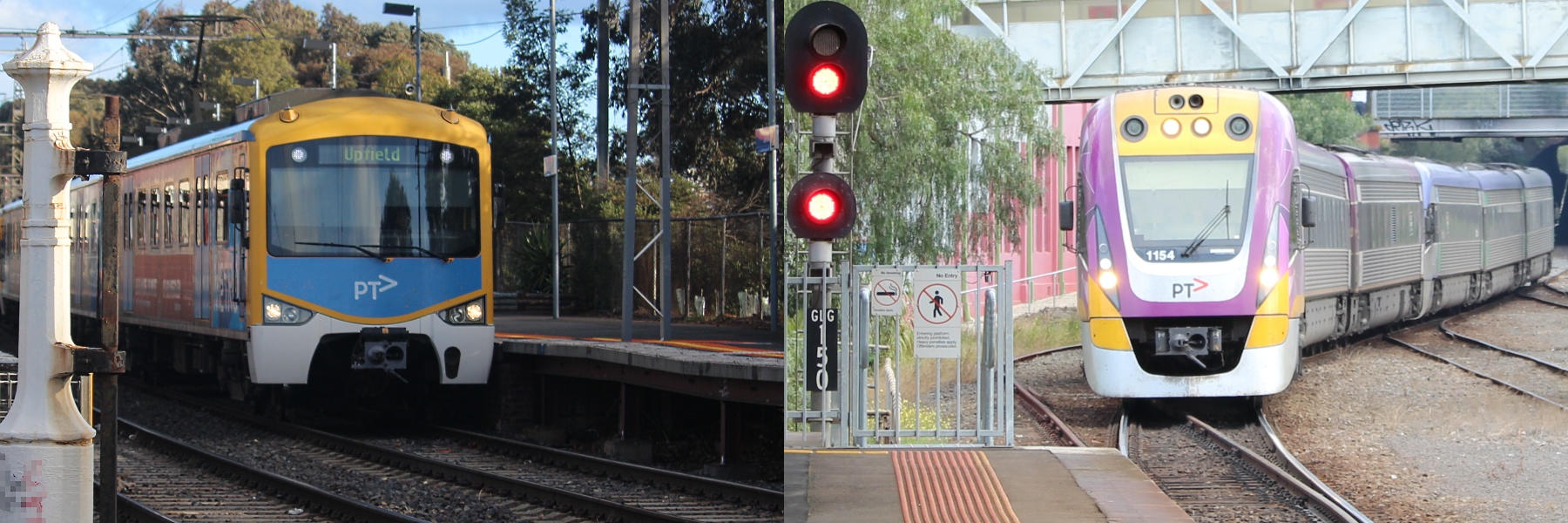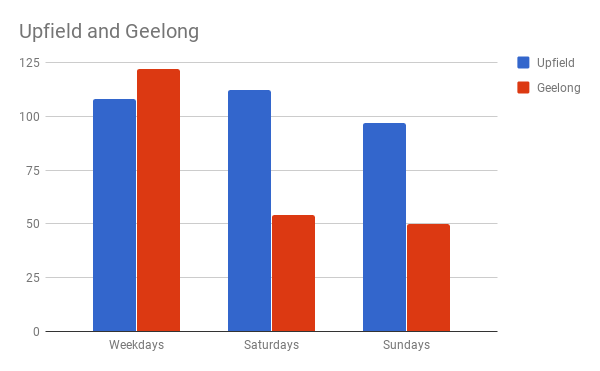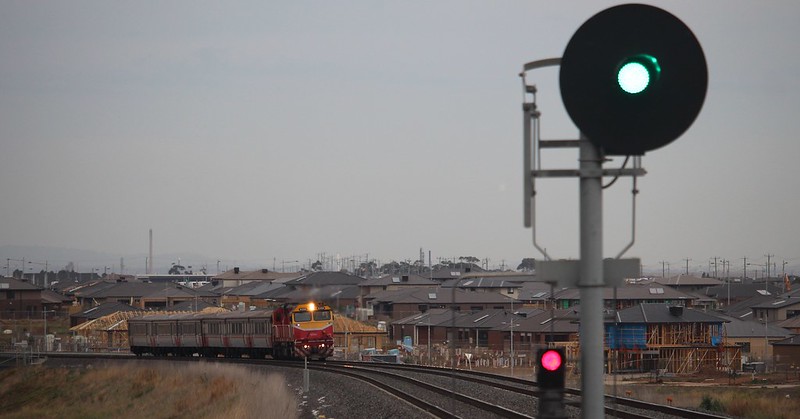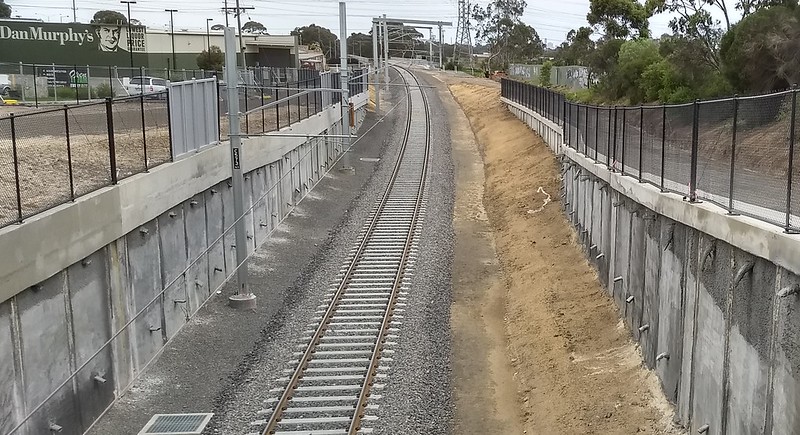I can’t remember who asked the question, but it was a good one:
Which has more trains? The Upfield line or the Geelong line?
They’re quite different rail lines.
The Upfield line serves Melbourne’s northern suburbs, and runs via the City Loop. It runs electric Metro services through 16 stations (plus 3 City Loop stations). The route is 23km long, and takes about 36 minutes.
The Geelong line serves Melbourne’s outer-western growth suburbs at Wyndham Vale and Tarneit (along with Deer Park, also on the Ballarat line) as well as the city and suburbs of Geelong, all the way out to Waurn Ponds. It runs diesel V/Line services. It’s about 93km to Waurn Ponds via Regional Rail Link, also with 16 stations, taking about 75 minutes.
And the answer to the question? If I’ve got my numbers right, overall the Upfield line has more services each week: 749 vs 714.
But the Geelong line has more on weekdays (122 vs 108), and has a lot more services during peak.
(Counts both directions. Night Coaches excluded. Night Network services were counted as part of the following day.)
Some things I noticed:
While the Upfield line peak is only three trains per hour (every 18-20 minutes), the Geelong line is more intensive, with 8 trains arriving at Southern Cross between 7:30 and 8:30am (some originating at Wyndham Vale).
The Geelong line is more tidal. Counting peak as before 9am, and 3pm-7pm, there are six more trains in the peak direction than counter-peak, meaning V/Line has to find central city stabling for those trains during the day. The Upfield line is balanced, partly because the peak service is basically no more frequent than off-peak.
On weekends there’s no contest: the Upfield line runs every 20 minutes for most of the day, with the Geelong line at half that frequency — woefully inadequate for a train line serving suburban areas.
There are more trains in the evenings on the Upfield line, half-hourly, but not by much, as the Geelong line runs about every 40 minutes.
Monday to Thursday nights, the Geelong line has a last train that’s far later than any Metro line: departing Southern Cross at 1:15am.
On the Upfield line, stopping patterns are fairly simple. Between North Melbourne and Upfield every train stops at every station.
The only variations are at the City end due to the City Loop:
- some trains via the Loop clockwise (weekday AM and weekends)
- some anti-clockwise (weekday PM)
- and some direct via Southern Cross (Night Network, after midnight on Friday and Saturday nights)
There’s a myriad of stopping patterns on the Geelong line, at least on weekdays.
Firstly, trains originate and terminate at: Waurn Ponds, Marshall, South Geelong, Geelong and Wyndham Vale, as well as a few running to/from Warrnambool — combined with varying platforms at Southern Cross, this leads to confusion for passengers at the Melbourne end looking for their next train.
Trains to Tarneit/Wyndham Vale/Geelong every 20 mins, from platform 15B, 2B, 5A, or 1. Hmm. #VLine #SoCross pic.twitter.com/3FaQV7lwMo
— Daniel Bowen (@danielbowen) June 25, 2015
And the station stopping patterns are all over the place. Just between Geelong and Melbourne inbound, just before 10am on weekdays, I can see:
- All stations to Tarneit, then express to Sunshine
- Express North Geelong to Lara to Wyndham Vale, then express Tarneit to Sunshine
- All stations except Ardeer
- Express North Geelong to Lara, and express Tarneit to Sunshine
- Express Lara to Wyndham Vale, and express Tarneit to Sunshine
- Express North Geelong to Lara, and express Tarneit to Footscray
- Express Lara to Sunshine
- Express Tarneit to Ardeer
- Express North Geelong to Lara, and express Wyndham Vale to Footscray
- Express Lara to Tarneit, then express to Sunshine
- All stations (from Wyndham Vale)
- Express Lara to Footscray
- Express North Geelong to Lara, express Little River to Tarneit to Sunshine
- Express Geelong to Footscray
- Express North Shore to Lara to Wyndham Vale, and express Deer Park to Sunshine
- Express North Geelong to Corio, and express Deer Park to Sunshine
Unless I’ve miscounted, that’s 16 different stopping patterns in just the first 22 trains to Melbourne on a weekday. Amazing. It must confuse the drivers no end.
With all these variations, plus the line sharing tracks from Deer Park in with the Ballarat trains, and Bendigo trains from Sunshine in, it’s no wonder the punctuality is a mess. For it to work, every train would have to be right on time, every time… which they aren’t, because regional train designs are really slow for loading the large numbers of passengers who use these services.
The Geelong line has single track at the outer end, for most of the way from Geelong to Waurn Ponds, though this is set to be duplicated soon. For now though, it causes issues, including some counter-peak trains not stopping at Marshall because while there’s a passing loop, there’s no platform on it.
The Upfield line’s single track is also a bottleneck. So you’d think it would be a priority to fix? But no — the recent Camp Road level crossing removal (costing around $85 million) made provision for it, but didn’t actually fix it.
The single track doesn’t just make running frequent services difficult; it also means any little delay can quickly snowball – and to avoid this, Metro will often terminate/originate trains at Coburg instead, leaving a big gap in services between Coburg and Upfield. This just yesterday in morning peak hour, following an earlier disruption:
Upfield Line – Major Delays – The 8:02 Upfield to FSS service has been altered and will originate from Coburg today at 8:13. Next train departs Upfield at 8:20
— Not Metro Notify (@NotMetroNotify) May 7, 2018
Despite this, it is actually possible to run more trains on the Upfield line, every 10 minutes as far as Coburg. How do we know this? Because it happened during the 2006 Commonwealth Games to better serve venues at Royal Park. These days there’d need to be some jumping through hoops at the city end, since the Northern Loop is full until the Metro tunnel is completed, but some trains direct into Southern Cross would be possible.
Changes coming?
Regional Rail Link brought trains to Melbourne’s outer west, but brought with it the challenges of services for regional Victoria sharing with suburban travellers — something at which V/Line really hasn’t excelled.
In the near future we’ll get an idea of what the State Government has planned for the regional rail network. Separating it from suburban services — giving Tarneit and Wyndham Vale a Metro service — has to be a priority.
And hopefully the Upfield line (and all the other Metro lines) will get full duplication and frequent all-day services… in our growing city, this is nothing less than Melburnians need and should expect.





24 replies on “Which has more trains? The Upfield line or the Geelong line?”
There are at least three problems with just going ahead and duplicating the Upfield line:
1. Barry Rd level crossing;
2. Upfield Station single platform; and
3. Possibility of a Campbellfield station.
If there’s any chance of a new station, then adding a bike path north of the Ring Road probably won’t happen until the station is built, even if the line is duplicated first.
Issues 1 and 2 above could together be resolved with duplication with an elevated rail over Barry Rd. (A stabling facility could still be used if designed for a future extension to Roxburgh Park. )
I’m guessing the demographic mix is different for Geelong and Upfield. More students would use Upfield line (not many Geelong school students would commute to Melbourne each day). More pensioners would use Geelong line and almost all in off peak.
Yes, confusing signs at Southern Cross for someone who just wanted to get to Geelong and didn’t know about Geelong’s suburbs.
Good blog as always! Would also be worth comparing off peak and weekend frequency at each station across the Metro network by population catchment. Eg Poort frequency beyond Eltham but Diamond Ck has lots of people.
The same upfield train terminated at Coburg today too – that’s twice in one week. It’s mind boggling that an area so close to the city regularly has a 40 minute gap between peak hour servicee
I hardly use the PTV app but I would like to mention one positive thing about the VLine mobile App. I have registered into the app that my daily commute is from WyndhamVale to Southern cross and vice versa. Now whenever I enter into the app from my home, it shows when’s the next train to Southern cross and whenever I enter into the app from city, it shows me the list of trains (time and platform no) to Wyndham Vale. All happens based on automatic location detection of my phone, just enter into the app and it will just work, no need push more buttons or scroll. This is quite helpful even though the Geelong line trains have so many confusing start-stop pattern. I really appreciate VLine for including the platform no update in their app recently and I would like them to encourage people more to use their very useful and simplified app. They should put some signboards inside the trains to let people know about this app. VLine’s sms update is also quite helpful.
One of the solutions to the congestion in Geelong lines can be, introducing the discounted fare option for the VLine commuters who touch off their myki at Southern cross before 7 AM. It can be up to 100% discounted (to match with Metro) for the people who take the train from Wyndham Vale/Tarneit (or Melton/Caroline spring/Sunbury) and up to 50% discounted for the people who take the train from regional stations near Geelong (or Ballarat/Bendigo).
One of the major bottlenecks of regional line is the flat-junction where Geelong line meets the Ballarat line followed by two level crossings in DeerPark. Trains have to be slowed down a lot in this place. I wish the state Govt. remove this bottleneck as one package of work. It will also hinder running more train in Melton line after the duplication is completed. It makes me sad to think that it was not done as part of the RRL project.
I have one question to Daniel. Do you think the track for the Geelong line can support high speed train (eg. 200km/h)? I have heard somewhere that for the duplication of Melton line they are considering the train speed to be 160km/h only.
Now that the Dandenong line skyrail has been built and the Earth hasn’t fallen in, I wonder whether additional level crossings based on skyrail will be considered (after the November state election).
It would make sense to elevate the Upfield line using Skyrail between Park Street Brunswick and Bell Street in one large project. It would remove more than a dozen level crossings, including Brunswick Rd, Moreland Rd and Bell St, and provide for some exciting urban renewal opportunities. It could also facilitate a cycling highway into the city.
Perhaps the skyrail approach will be be viewed more palatably once the Dandenong corridor is fully open.
I’ve been on an outbound Upfield limited express. Maybe it was station skipping. It was fun going through the inner northern suburbs at high speed.
To be fair, most of the Upfield line runs adjacent to the frequent running number 19 tram service and is also criscrossed by buses that connect it to suburbs that are serviced by the Cragieburn and the South Morang line. Geelong commuters aren’t that well blessed (as with commuters living in the northern parts of the Upfield line). People living in Tarneit and Wyndham Vale though could still connect to the well used Werribee line. It’s hard to see increases in frequency to the Upfield line with so many level crossing along it, probably more much than the Vline to Geelong (if I am not mistaken).
However, interesting observation on your part.
How much will the Wallan Electrification via the Upfield-Somerton Link and Duplication cost around ?
The Epping line (as it was then, just before it became the South Morrang line) was duplicated between Keon Park and Epping over 4 previously single track road level crossings (Paschke Cresent was already double track because of the passing loop at Lalor) and 2 pedestrian level crossings, so a single level crossing duplication should be fine. The single track could, if the level crossing was an issue, finish just short of the level crossing.
There is plenty of space at Upfield for a second platform, although if/when duplication to Upfield takes place there would be enough capacity for suburban termination to run more services than the line needs or can handle between North Melbourne and Jewel (barring an upgrade) for quite some time. The main reason for a second Upfield platform would be through trains, either through suburban trains to Roxborough Park/Craigieburn/Wallan or V-Line Seymour and Shepparton services (diverted from the crowded Craigieburn line).
Campbellfield station would be no problem with duplication, but highly problematic without. It would provide much needed interchange with the 902 and serve its local area as well.
Diverting the Seymour/Shepparton line via the Upfield line, needs to be done sooner rather than later because of growing patronage on the Craigieburn line.
There are eleven road level crossings between Geelong and the RRL junction, 22 on the Upfield line and a further 10 between Geelong and Waurn Ponds. So currently there are more level crossings on the Upfield line than the regular services proportion of the Geelong line, with 10 more on the route via Newport. There are 3 pedestrian level crossings on the Geelong line (all at stations between North Shore and Little River), versus 9 on the Upfield line.
@Tom the first and best, Barry Rd is an arterial road. There is the possibility of it being connected to a new road to the airport (Attwood Connector) resulting in a significant increase in trucks and other traffic using it. It can be a convenient commuting cycling route from the City of Whittlesea LGA. The crossing requires, or will require, grade separation and it would be preferable, at least IMHO, for the rail to change level, not the road.
Also, I’d be interested to know, how do people expect the VLine Seymour services to change onto the Upfield extension across the SG ARTC track/s?
@Aaron, perhaps someone can answer in terms of costs, but if the whole Wallan extension has its own new tracks, ie without crossing the SG ARTC track/s onto the existing BG VicTrack tracks, that’s about 30km extra of rail as well as overhead power. Plus, brand new platforms (basically, new stations) for the several stops along there (eg Summerhill Rd, Donnybrook, Beveridge, Wallan). That also means goodbye Donnybrook Hotel. Several level crossings would require grade separation, if not straight away then eventually (eg Summerhill Rd, Donnybrook Rd, Minton St/Beveridge Rd, Wallan-Whittlesea Rd, plus any new roads constructed for new estates).
Some, or even much, of this expense would still be required no matter whether the extension crosses or does not cross the SG ARTC tracks to use the existing BG VicTrack tracks.
I reckon the total cost would be very much! Can someone confirm it?
I have a feeling that the Upfield line won’t be duplicated anytime soon until the government commits to permanently redirecting Seymour and Shepparton Vline services through the Upfield line. It would probably be only then that we will see the 2nd track added as well as the possible removal of the Level Crossings along the line and the possible addition of a new station at Campbellfield to service the shopping area. However on the topic of Level Crossing removals I think it would be very hard to remove the crossings at Royal Park without dramatically changing the landscaping, the Macaulay road crossing will almost be impossible (unless im wrong) due to Citylink above it and the creek flowing next to the Upfield line and the crossings between Gowrie and Fawkner would be quite controversial since the railway line cuts through the Fawkner cemetery and would possibly affect the graves.
Geelong line problems are the predictable result of the original unwise decision to try to make one new line double as a suburban extension as as a new line to Geelong. The result is neither fish nor fowl. As a suburban line, it’s infrequent and inefficient. As an intercity line, it’s a sad waste: $4 billion to make the line to Geelong 10km longer (!) with services that take about the same time as they did did before.
The Tarneit line originated as a thought bubble in the 2008 Eddington transport plan, then grew legs simply because at the time there happened to be a federal Labor government that wanted to throw some money at urban rail. It was never properly justified, and more cost-effective alternatives to increase capacity were never considered. [note 1]
The present Geelong service is only a few minutes faster than what would have been obtained by simply electrifying the line and extending the present *all stops* Werribee trains to Geelong. That gives you an idea of what a damp squib the Regional Rail Link outcomes have been for Geelong.
note 1: for example, electrify the existing line and extend platforms for 9-car trains. 9-car trains could operate from Werribee to Dandenong via Flinders St direct . The existing line could easily handle a peak service of 4 per hour to Williamstown, 8 to Laverton/Werribee and 4 to Geelong. With 9-car trains that would give total capacity much greater than the present service.
Extending platforms would be tricky, but definitely possible, at North Melbourne, Flinders St and Richmond, and would be fairly straightfoward elsewhere (or rather, would have been straightforward until the Skyrail works on the Dandenong line foolishly closed off that option).
Re “Extending platforms would be fairly straightfoward elsewhere (or rather, would have been straightforward until the Skyrail works on the Dandenong line foolishly closed off that option”
Each new station has provision at one end to be extended to serve 10 car long HCMTs:
https://www.danielbowen.com/2018/03/19/cfd-dng-skyrail-nears-completion/
Barry Rd may get its level crossing eliminated or it may not (its not on the current list) but it is not necessary for duplication, suburban service increase or Seymour/Shepparton diversion. Major level crossing abolition would only be needed for extra services when it got to Dandenong line service levels (about 18 trains per hour in peak), which won`t happen before Wallan is electrified and probably not for some time after. Even then, well after the government has got through abolishing Bell St, Coburg and Moreland Rd, Brunswick (which are on the list), Brunswick Rd, Brunswick and potentially Gaffney St, Coburg North and Boundary Rd, Hadfield would be higher priorities.
A Liberal government probably would not duplicate Upfield without Seymour/Shepparton diversion but an ALP government has a far greater interest in winning votes in the seats on the Upfield line.
The other level crossings on the Upfield line are definitely a higher priority than Barry Rd. I’m with @Filly in feeling that the full duplication won’t occur anytime soon. (A Campbellfield station with a turnback and duplication from Gowrie would be more likely.) In the meantime, the drivers of late-running buses at Upfield station will continue to point to the level crossing and blame that for the poor performance of the buses.
Another 6000 houses planned. The owners got $200M for selling it.
https://www.realestate.com.au/news/family-hits-pay-dirt-with-200-million-farm-sale-north-of-melbourne/?rsf=syn:news:nca:hs:article
From what I can see near Berveridge, tho no payment from the $200M for value capture.
It system seems all broken,
there is value capture of sorts… https://www.sro.vic.gov.au/growth-areas-infrastructure-contribution
Upfield has several pressures in favour of duplication.
Firstly, there is significant population growth, with accompanying patronage and potential patronage, along the line as flats are built near the stations, often where there were industrial properties with lower patronage potential than housing.
Secondly, the growing patronage along the Craigieburn line means that there is pressure to move the Seymour and Shepparton trains to the Upfield line, which cannot be done without duplication (and likely a signalling upgrade North Melbourne-Jewel, to allow trains closer together).
Thirdly, the growing development between Craigieburn and Wallan is creating pressure for extension of the suburban network to Wallan and that needs to go via the Upfield line due to greater available potential capacity.
Fourthly, the capacity constraints at the city end (loop capacity, Southern Cross platform capacity reducing the ability to use platform 8 for suburban trains and the inability to run direct services to Flinders St due to the requirement for too many conflicting movements) are due to no longer be capacity constraints with the opening of Metro Tunnel 1 due in 2025, allowing more train to run in and outside peak hour.
Fifthly, partial duplication is unlikely as it would only mean lower reliability and returning later to complete the duplication for reducing several of the other issues listed here.
I was doubting my memory. Not running now but in 2015 the 9:20 from Flinders Street to Upfield ran express for about four stations to Coburg.
[…] would also further complicate the timetable, which already has an incredible 16 different stopping patterns in just the morning inbound services before 10am. More consistency would help cut delays and even […]
[…] is red stations close to the City. Some of these I expected, such as the Upfield line, with only a basic service all day, in part due to the single […]